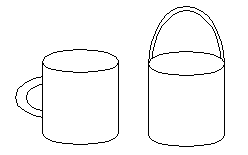|
|
 If pigeons recognize objects using local
features alone, then variations in the arrangement of those features would
have little or no impact on the accuracy of recognition. Thus, unlike humans,
the pigeon would be incapable of discriminating between the cup and the
pail. The cup and the pail are comprised of two components: a cylinder
and a curved handle. However, the orientation and position of the handle
relative to the cylinder differs between the objects. In order to discriminate
the cup from the pail, one must be able to recognize the differences in
the organization of the components, a more global property of objects. Several
experiments by Kirkpatrick-Steger, Wasserman, and Biederman have demonstrated
that pigeons can discriminate changes in spatial organization, and that
spatial organization plays a key role in picture recognition in pigeons. There is, however, one difference in
the local features of the cup and pail -- the points of contact (intersections)
between the handle and cylinder differ slightly. If pigeons were attentive
to fine variations in local features (as PFT argues), then the differences
in contact pionts could prove sufficient in differentiating between these
objects. Kirkpatrick-Steger, Wasserman, and Biederman
(1998) ruled out the contribution of the contact points as a significant
contributor to object recognition in pigeons. If pigeons recognize objects using local
features alone, then variations in the arrangement of those features would
have little or no impact on the accuracy of recognition. Thus, unlike humans,
the pigeon would be incapable of discriminating between the cup and the
pail. The cup and the pail are comprised of two components: a cylinder
and a curved handle. However, the orientation and position of the handle
relative to the cylinder differs between the objects. In order to discriminate
the cup from the pail, one must be able to recognize the differences in
the organization of the components, a more global property of objects. Several
experiments by Kirkpatrick-Steger, Wasserman, and Biederman have demonstrated
that pigeons can discriminate changes in spatial organization, and that
spatial organization plays a key role in picture recognition in pigeons. There is, however, one difference in
the local features of the cup and pail -- the points of contact (intersections)
between the handle and cylinder differ slightly. If pigeons were attentive
to fine variations in local features (as PFT argues), then the differences
in contact pionts could prove sufficient in differentiating between these
objects. Kirkpatrick-Steger, Wasserman, and Biederman
(1998) ruled out the contribution of the contact points as a significant
contributor to object recognition in pigeons.
|
![]()